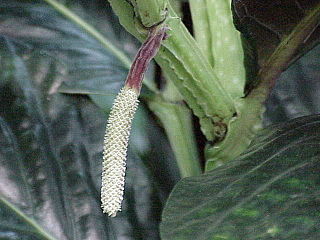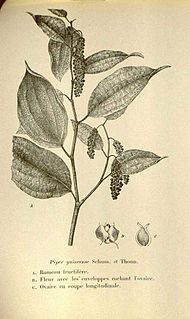
Piper, the pepper plants or pepper vines, is an economically and ecologically important genus in the family Piperaceae.

Zingiberaceae or the ginger family is a family of flowering plants made up of about 50 genera with a total of about 1600 known species of aromatic perennial herbs with creeping horizontal or tuberous rhizomes distributed throughout tropical Africa, Asia, and the Americas.

Aframomum melegueta is a species in the ginger family, Zingiberaceae, and closely related to cardamom. Its seeds are used as a spice ; it imparts a pungent, black-pepper-like flavor with hints of citrus. It is commonly known as grains of paradise, melegueta pepper, alligator pepper, Guinea grains, ossame, or fom wisa. The term Guinea pepper has also been used, but is most often applied to Xylopia aethiopica.

Malagueta pepper, a variety of Capsicum frutescens, is a type of chili pepper widely used in Brazil, the Caribbean, Portugal, Mozambique, Angola, and São Tomé and Príncipe. It is heavily used in the Bahia state of Brazil. It apparently got its name from the unrelated melegueta pepper from West Africa, because of a similar level of piquancy.

Pepper Coast, also known as the Grain Coast, was the name given by European traders to a coastal area of western Africa, between Cape Mesurado and Cape Palmas. It encloses the present republic of Liberia.

Ras el hanout or rass el hanout is a spice mix found in varying forms in Tunisia, Algeria, and Morocco. It plays a similar role in North African cuisine as garam masala does in Indian cuisine. The name in Arabic means "head of the shop" and implies a mixture of the best spices the seller has to offer. Ras el hanout is used in many savory dishes, sometimes rubbed on meat or fish, or stirred into couscous, pasta or rice.
Traditionally, the various cuisines of Africa use a combination of locally available fruits such as, cereal grains and vegetables, as well as milk and meat products, and do not usually have food imported. In some parts of the continent, the traditional diet features an abundance of milk, curd and whey products.

Piper cubeba, cubeb or tailed pepper is a plant in genus Piper, cultivated for its fruit and essential oil. It is mostly grown in Java and Sumatra, hence sometimes called Java pepper. The fruits are gathered before they are ripe, and carefully dried. Commercial cubeb consists of the dried berries, similar in appearance to black pepper, but with stalks attached – the "tails" in "tailed pepper". The dried pericarp is wrinkled, and its color ranges from grayish brown to black. The seed is hard, white and oily. The odor of cubeb is described as agreeable and aromatic and the taste as pungent, acrid, slightly bitter and persistent. It has been described as tasting like allspice, or like a cross between allspice and black pepper.
African pepper is a name for several unrelated pepper-like spices traded from the general region of West Africa:

Xylopia aethiopica is an evergreen, aromatic tree, of the Annonaceae family that can grow up to 20m high. It is a native to the lowland rainforest and moist fringe forests in the savanna zones of Africa.

The cuisine of Senegal is a West African cuisine influenced by North African, French, and Portuguese cuisine and derives from the nation's many ethnic groups, the largest being the Wolof. Islam, which first penetrated the region in the 11th century, also plays a role in the cuisine. Senegal was a colony of France until 1960. Ever since its colonization, emigrants have brought Senegalese cuisine to many other regions.

Alligator pepper is a West African spice made from the seeds and seed pods of Aframomum danielli, A. citratum or A. exscapum. It is a close relative of grains of paradise, obtained from the closely related species, Aframomum melegueta. Unlike grains of paradise, which are generally sold as only the seeds of the plant, alligator pepper is sold as the entire pod containing the seeds.

Piper guineense is a West African species of Piper; the spice derived from its dried fruit is known as Ashanti pepper, Benin pepper, Edo pepper, false cubeb, Guinea cubeb, and called locally kale, kukauabe, masoro, etiñkeni, sasema, soro wisa, eyendo, oziza and uziza. It is a close relative of cubeb pepper and a relative of black pepper and long pepper. Unlike cubeb, which is large and spherical in shape, Ashanti pepper grains are prolate spheroids, smaller and smoother than Cubeb pepper in appearance and generally bear a reddish tinge. The stalks of Ashanti pepper berries are also distinctly curved whilst those of cubeb pepper are completely straight. The terms West African pepper and Guinea pepper have also been used, but are ambiguous and may refer to grains of Selim or grains of paradise.

West African cuisine encompasses a diverse range of foods that are split between its 16 countries. In West Africa, many families grow and raise their own food, and within each there is a division of labor. Indigenous foods consist of a number of plant species and animals, and are important to those whose lifestyle depends on farming and hunting.

Paprykarz szczeciński is a Polish canned fish spread made from ground fish, rice, tomato paste and vegetable oil, seasoned with onion, salt and spices. It has the form of a reddish-brown paste with visible rice grains. The recipe, inspired by a West African dish sampled by Polish fishermen, was developed in the 1960s at PPDiUR Gryf, a state-owned far-sea fishing and fish processing company based in the Polish port city of Szczecin. Since the company's bankruptcy in the early 1990s, paprykarz szczeciński has been produced by other fish processing plants in various locations throughout Poland. A popular snack, especially with students and hikers, it remains a symbol of Szczecin's local identity.

Grains of Selim are the seeds of a shrubby tree, Xylopia aethiopica, found in Africa. The seeds have a musky flavor and are used as a spice in a manner similar to black pepper, and as a flavouring agent that defines café Touba, the dominant style of coffee in Senegal. It is also known as Kani pepper, Senegal pepper, Ethiopian pepper, and (historically) Moor pepper and Negro pepper. It also has many names in native languages of Africa, the most common of which is diarr in the Wolof language. It is called 'Etso' in the Ewe language of Ghana. It is sometimes referred to as African pepper or Guinea pepper, but these are ambiguous terms that may refer to Ashanti pepper and grains of paradise, among others.

Café Touba is a coffee beverage that is a popular traditional drink of Senegal and Guinea-Bissau, and is named for the city of Touba, Senegal.

Guinea-Bissauan cuisine is the food culture of Guinea-Bissau, a nation on Africa's west coast along the Atlantic Ocean. Rice is a staple in the diet of residents near the coast and millet a staple in the interior. Much of the rice is imported and food insecurity is a problem in large part due to coups, corruption and inflation. Cashews are grown for export. Coconut, palm nut, and olives are also grown.

The cayenne pepper is a type of Capsicum annuum. It is usually a moderately hot chili pepper used to flavor dishes. Cayenne peppers are a group of tapering, 10 to 25 cm long, generally skinny, mostly red-colored peppers, often with a curved tip and somewhat rippled skin, which hang from the bush as opposed to growing upright. Most varieties are generally rated at 30,000 to 50,000 Scoville units.















